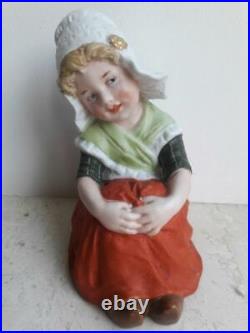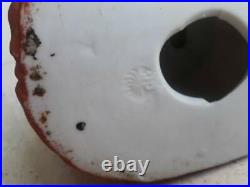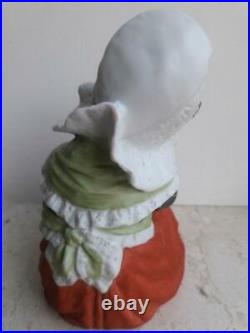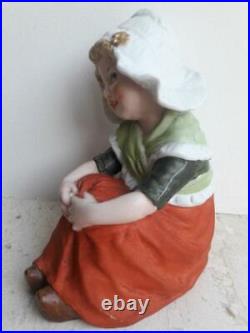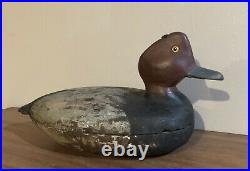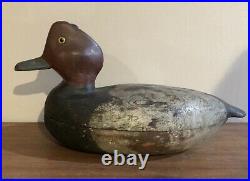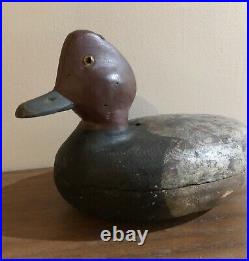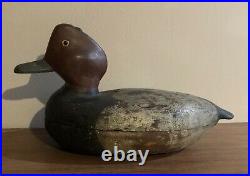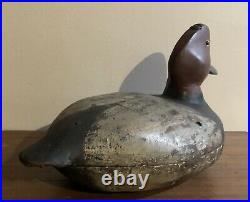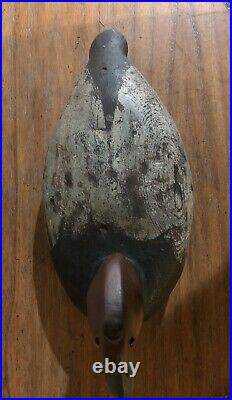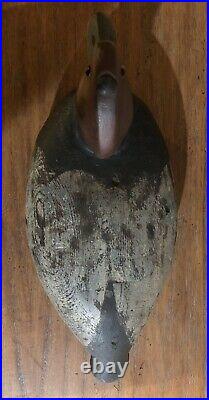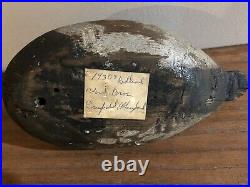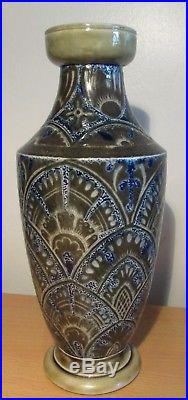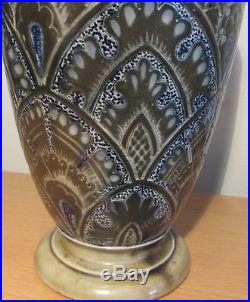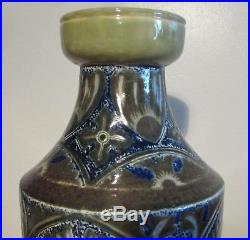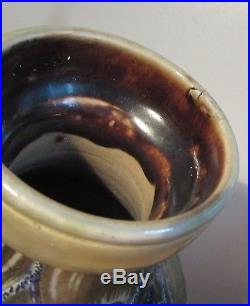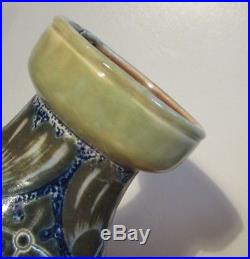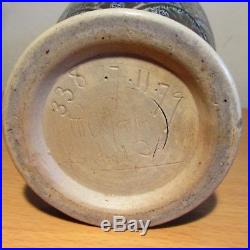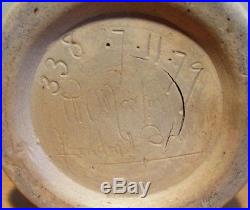
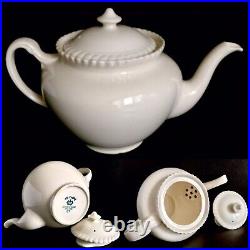
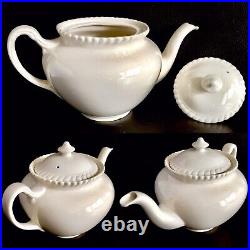
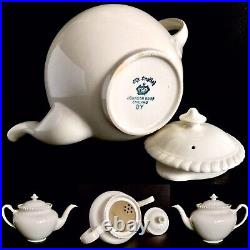


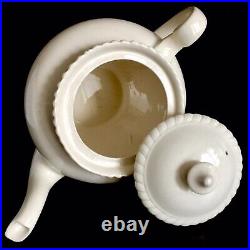

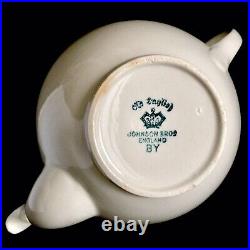
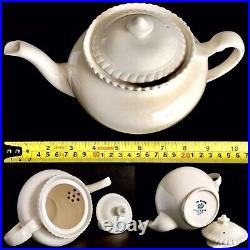
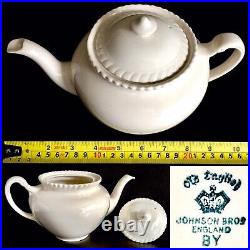
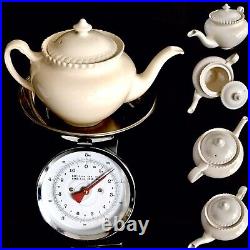

Rare Antique George V (1913) Johnson Brothers “Old English” Ironstone Cream Ware Teapot In Perfect condition (10/26cm, 700g). Never used and in excellent condition as shown in 12 pictures attached. Only ever been a cabinet display item. The back stamp dates the teapot to circa 1913 making it well over a 100 years old. Please browse all 12 sets of photographs attached for size, weight and condition as they are self explanatory. A lovely standard size teapot. George V (George Frederick Ernest Albert; 3 June 1865 – 20 January 1936) was King of the United Kingdom and the British Dominions, and Emperor of India, from 6 May 1910 until his death in 1936. The four’Johnson Brothers’ were Alfred, Frederick, Henry and Robert (Grandsons of the famous Meakin lineage) – sons of Robert Johnson. Alfred, Frederick began production at the Charles Street works, Hanley, Stoke-on-Trent in 1883 for the manufacture of durable Earthenware, which they called “White Granite”. In 1888, Henry joined them. In addition to manufacturing well-potted white ware, they began producing under-glaze printed ware for which they became famous. Due to the increased demand for pottery after the Civil War, they opened up two new factories in Hanley close to their original factory. By 1898, they had five different factories producing tableware. Charles Street works, Imperial Works, Hanley Works & Trent Works in Hanley and the Scotia Road works in Tunstall. Robert, moved to New York in the United States of America around 1896 to establish a presence in the tableware market that was emerging. Johnson Brothers tableware was becoming very popular in America due to its inexpensive and durable product. Johnson Brothers continued its growth in the tableware industry into World War I. When the war was over, production was able to resume at its pre-war pace. At the start of the Twenties, new shapes, patterns, and bodies were introduced and the “Dawn” range of colored bodies began for which Johnson Brothers became very well known. New methods were developed for making halloware items which allowed for a more rapid production over the old method of using pressed clay. At the end of the Twenties, the grandsons of the founders entered the business. During the Thirties the Charles Street Works, the original factory was closed. It was not until the mid-Thirties that the factories got under full production. At the end of the Thirties, was seen the development of modern systems of firing using electricity as fuel rather than raw coal and new brick-built tunnels using an automatic ware-propelling system replaced the traditional Bottle Ovens. The more accurately controlled firing system meant better quality and less loss and the conditions for the wokers was much more superior than before. A new mold-making department and making shops accompanied the construction of the electric kiln. The Second World War came and nearly halted production at Johnson Brothers factories. War damage and the need for increased productivity dictated a major overhaul of the Johnson Brothers factories. Modern equipment and larger facilities were installed to improve the day-to-day production capability of the company. In 1968, to offer access to even larger markets, and to remain competitive, Johnson Brothers joined the Wedgwood Group. Several other manufacturers including Meakin (the Johnson Brother’s maternal Grandfather’s company), Coalport, Adams, Midwinter, Crown Staffordshire, and Mason’s joined, as well. Around 2000 the tableware division of Johnson’s mover to the nearby J & G Meakin Eagle Pottery works where they produced until 2004 when manufacturing was transferred abroad. The Eagle Pottery works were demolished in 2005. Founded in 1883 by four brothers, Henry, Robert, Alfred and Fred Johnson. The business was at first on a modest scale, but in the last 70 years has expanded until today Johnson Bros. Is probably the largest firm of earthenware manufacturers in the world, controlling a number of factories in England and abroad. The present head of the firm is Sir Ernest Johnson. Starting with the production of’Granite’ for overseas markets, the firm has developed in the twentieth century fine self-coloured bodies, Gray dawn in 1929, followed by Rose, Green and Golden dawn. A new shape has been made each year. Finley engraved table wares are a specialty,’Old Britain Castles’ engraved by Fennell being one of the most notable. The potting of this firm is distinguished by uncommon lightness and finish. Before the first World War Johnson Bros. Owned a sanitary earthenware factory in Germany, but it was closed down in 1914. In 1947 Johnsons acquired a controlling interest in the Canadian tableware business of Sovereign Pottery Ltd. At Hamilton, Ontario along with its factory. In 1957 Johnsons opened a tableware factory at Croydon, Queensland, Australia, which was run through a firm also known as Sovereign Pottery Ltd. Creamware is a cream-coloured refined earthenware with a lead glaze over a pale body, known in France as faïence fine, in the Netherlands as Engels porselein, and in Italy as terraglia inglese. It was created about 1750 by the potters of Staffordshire, England, who refined the materials and techniques of salt-glazed earthenware towards a finer, thinner, whiter body with a brilliant glassy lead glaze, which proved so ideal for domestic ware that it supplanted white salt-glaze wares by about 1780. It was popular until the 1840s. Variations of creamware were known as “tortoiseshell ware” or “Whieldon ware” were developed by the master potter Thomas Whieldonwith coloured stains under the glaze. It served as an inexpensive substitute for the soft-paste porcelains being developed by contemporary English manufactories, initially in competition with Chinese export porcelains. It was often made in the same fashionable and refined styles as porcelain. The most notable producer of creamware was Josiah Wedgwood, who perfected the ware, beginning during his partnership with Thomas Whieldon. Wedgwood supplied his creamware to Queen Charlotte and Catherine the Great (in the famous Frog Service) and used the trade name Queen’s ware. Later, around 1779, he was able to lighten the cream colour to a bluish white by using cobalt in the lead overglaze. The Leeds Pottery (producing “Leedsware”) was another very successful producer. And to the United States. One contemporary writer and friend of Wedgwood claimed it was ubiquitous. This led to local industries developing throughout Europe to meet demand. There was also a strong export market to the United States. The success of creamware had killed the demand for tin-glazed earthenware and pewter vessels alike and the spread of cheap, good-quality, mass-produced creamware to Europe had a similar impact on Continental tin-glazed faience factories. By the 1780s Josiah Wedgwood was exporting as much as 80% of his output to Europe. Creamware is made from white clays from Dorsetand Devonshire combined with an amount of calcined flint. This body is the same as that used for salt-glazed stoneware, but it is fired to a lower temperature (around 800 °C as opposed to 1,100 to 1,200 °C) and glazed with lead to form a cream-coloured earthenware. The white clays ensured a fine body and the addition of flint improved its resistance to thermal shock during firing, whilst flint added to the glaze helped prevent crazing. Creamware was first produced some time before 1740. Originally lead powder or galena, mixed with a certain amount of ground calcined flint, was dusted on the ware, which was then given its one and only firing. This early method was unsatisfactory because lead powder produced poisoning among the potters and the grinding of flint stones caused a disease known as potter’s rot. Around 1740 a fluid glaze in which the ingredients were mixed and ground in water was invented, possibly by Enoch Booth of Tunstall, Staffordshire, according to one early historian, although this is disputed. The method involved first firing the ware to a biscuit state, and then glazing and re-firing it. Foremost of the pioneers of creamware in the Staffordshire Potteries was Thomas Whieldon. Although he has become popularly associated almost exclusively with tortoiseshell creamware, in fact he produced a wide variety of creamware. He first mentions’Cream Colour’ in 1749. The young Josiah Wedgwood was in partnership with Thomas Whieldon from 1754 to 1759 and after Wedgwood had left to set up independently at Ivy House, he immediately directed his efforts to the development of creamware. Wedgwood rebelled against the use of coloured glazes, declaring as early as 1766 that he was clearing his warehouse of coloured ware as he was’heartily sick of the commodity’. Wedgwood improved creamware by introducing china-clay into both the body and glaze and so was able to produce creamware of a much paler colour, lighter and stronger and more delicately worked, perfecting the ware by about 1770. His superior creamware, known as’Queen’s ware’, was supplied to Queen Charlotte and Catherine the Great and later became hugely popular. There were few changes to creamware after about 1770 and the Wedgwood formula was gradually adopted by most manufacturers. There were approximately 130 potteries in North Staffordshire during the 1750s, rising to around 150 by 1763 and employing up to 7,000 people – a large number of these potteries would have been producing creamware. Whilst Staffordshire had taken the lead, creamware came to be developed in a number of large potting centres where stoneware was already being produced, eventually replacing stoneware entirely. These included Derbyshire, Liverpool, Yorkshire (including the Leeds pottery) and Swansea. Attribution of pieces to particular factories has always been difficult because virtually no creamware was marked prior to Josiah Wedgwood’s manufacture of it in Burslem. At the time manufacturers frequently supplied wares to one another to supplement stocks and ideas were often exchanged or copied. In addition, factories usually sent out their wares to outside specialist enamellers or transfer-printers for decoration – decoration in-house was only gradually adopted. For this reason, several manufacturers usually shared the same decorator or printer and tended to use the same or very similar patterns. Collectors, dealers and curators alike were frustrated in their efforts to ascribe pots to individual factories: it is frequently impossible to do so. Archaeological excavations of pottery sites in Staffordshire and elsewhere have helped provide some better-established typologyto enable progress in attribution. The heyday of creamware ran from about 1770 to the rise of painted pearlwares, white wares and stone chinas in the period around 1810 to 1825. Although creamware continued to be produced during the later period, it was no longer pre-eminent in the markets. Given the fickle nature of the consumer, much remarked upon by Wedgwood during his career, it is remarkable how long creamware remained popular in its many forms and it is precisely due this varied history it remains highly prized for collectors today. This item is in the category “Pottery, Ceramics & Glass\Decorative Cookware & Tableware\Bowls”. The seller is “santoor-uk” and is located in this country: GB. This item can be shipped worldwide.
- Origin: UK
- Number of Items in Set: One Teapot & Lid
- Antique: Yes
- Shape: As In Photos Attached
- Occasion: All Occasions
- Custom Bundle: No
- MPN: Pattern: Old English
- Year Manufactured: 1913
- Item Length: 10”/26cm
- Year of Manufacture: 1913
- Colour: Cream
- Date Range: 1900-1919 (Art Nouveau)
- Original/Licensed Reproduction: Original
- Style: George V
- Production Style: Pottery
- Finish: Glossy
- Handmade: Yes
- Pattern: Old English
- Use: Tableware
- Material: Porcelain/ China
- Set Includes: Teapot Only
- Date: 1900-1919 (Art Nouveau)
- Sub-Type: British
- Brand: Johnson Brothers
- Boxed/ Unboxed: Unboxed
- Type: Teapot
- Product Type: Teapot
- Era: Early 20th Century (1911-1940)
- Original/Reproduction: Antique Original
- Theme: British
- Time Period Manufactured: 1900-1919
- Production Technique: Pottery
- Country/Region of Manufacture: United Kingdom
- Backstamp: Printed
- Item Weight: 700g
- Product Line: Johnson Brothers



